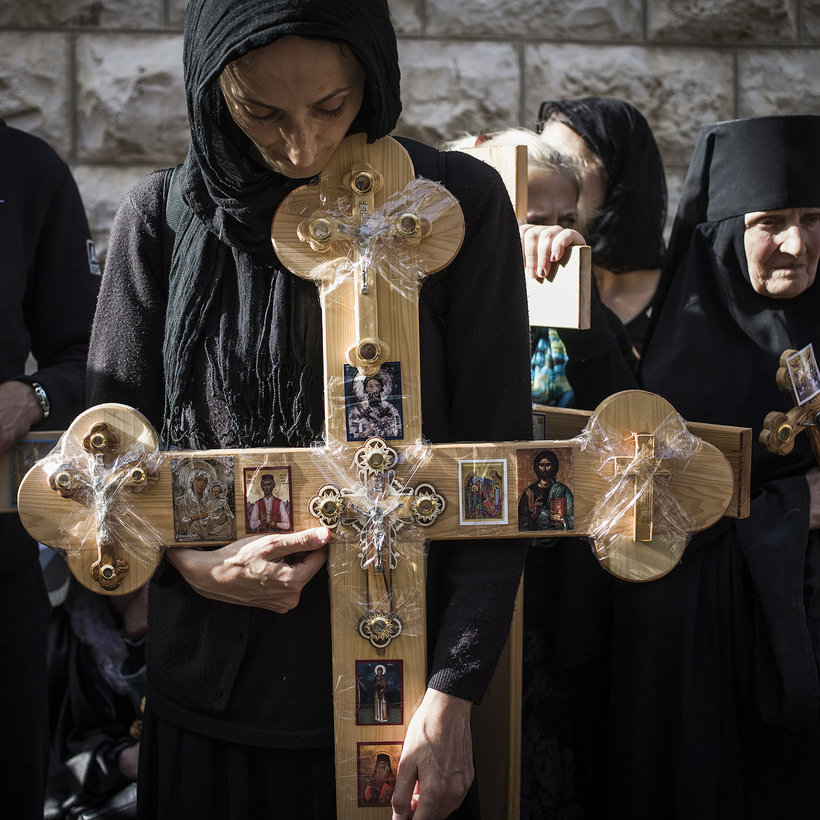One afternoon in Jerusalem, I bought Jesus a Diet Coke. I had run into the bearded and barefoot middle-aged man in white robes several times in the narrow alleys of the Old City. We had a nodding acquaintance, but I was always rushing off to my next interview, and he was usually on his way to Mass at the Holy Sepulchre.
This time I invited him into a nearby Arab café. A Detroit native, he lived without money and depended on the kindness of strangers for food and accommodations, and had long been a fixture in the Old City. He seemed like a gentle soul who followed in the literal footsteps of his savior.
Jerusalem is home not just to the Western Wall, the Dome of the Rock, and the site of Christ’s crucifixion; it also plays host to its own mental condition known as “Jerusalem Syndrome,” first described in the 1930s. In its most extreme form, a sudden psychosis prompts its victims to take on the persona of biblical figures, sometimes with the aid of a hotel bedsheet. With others, it can take a less severe form of obsession brought on by the intense religious nature of the city. Some 50 to 100 cases a year fill a special hospital ward.

The Russian writer Gogol was one of the first known sufferers, but the majority today are white American Protestants. According to an Israeli researcher, a healthy percentage of these arrive in the holy city with no pre-existing mental illness. One medical study recommends treatment through “early intervention and separation from Jerusalem and its holy places.”
Symptoms May Vary
While reporting on my upcoming book about the search for the city’s biblical past, it occurred to me that Jerusalem Syndrome takes milder forms that afflict politicians as well as casual tourists. Consider the two U.S. presidents who spent the most time and political capital attempting to resolve the Arab-Israeli conflict.
Jimmy Carter and Bill Clinton, our nation’s most devout and overtly Christian leaders, wrestled with this geopolitical nightmare like Jacob wrestled with the mysterious angel in the book of Genesis. Both were raised as Southern Baptists and believed that the Jewish return to Israel was divinely mandated. Both were also deeply moved by their first visits to Jerusalem, and left with the hope of finding a way to end the strife.

Carter’s first pilgrimage was as Georgia governor in 1973, four years before he arrived at the White House. He rose before sunrise—and other tourists—“to catch a flavor of how it might have been two thousand years earlier, when Jesus strolled the same streets.” When not meeting with Israeli leaders, he spent hours conversing with Jewish archaeologists who were seeking physical remains from biblical times. The experience sparked what he called his “deep commitment” to Jerusalem.
Eight years later, following a failed bid for a second term as Arkansas governor, Clinton eagerly “relived the history of the Bible” with his pastor, who served as guide during his first Jerusalem visit. “It was the beginning of an obsession to see all the children of Abraham reconciled on the holy ground in which our three faiths came to light,” he later recalled. “That trip left a lasting mark on me.”
Those visits also left a lasting mark on the region—and the world. As president, Carter shepherded the Camp David Accords that made peace between Israel and Egypt, though his attempt to settle the dispute around Jerusalem failed. Clinton took up the cause when he came to office in 1993, but those talks collapsed at his own Camp David meeting. Prospects for a lasting peace foundered again on the treacherous sacred rocks of Jerusalem.

Commentators pinned blame for this last disaster on Palestinian intransigence. But Clinton also proved so entrenched in his Baptist faith, with its Old Testament roots, that he failed to fully grasp how deeply Muslims felt about a city they know as simply “the Holy.”
The irony that Carter and Clinton never grasped was that they could not be truly honest brokers—Western Christians set the very wheels of the conflict in motion. Arriving in Jerusalem in the 19th century, they dug and dynamited their way to the city’s Old Testament past and turned the scrappy medieval town into a favorite Western tourist attraction. Muslim residents were alarmed and alienated even as European and American Jews were inspired and encouraged by Protestants to see Jerusalem as more than a symbol of lost glory, but as their eternal capital.
The past that Christians so eagerly sought to uncover with shovels and spades quickly became a tool of war between Jews and Muslims, who quarreled with each other over who had bragging rights to the holy city. The result was a bloody century where rocks and rubber bullets regularly flew along with the disputed claims of ancient ownership. Carter and Clinton didn’t need to wear white robes to reveal a religious obsession that clouded their practical political vision. The bitter fight over a city claimed by two peoples and three faiths continues unabated.
If the medical researchers are right, the only solution to the conflict in the City of Peace is the unlikely prospect of “separation from Jerusalem’s holy places.” The question I am left pondering is whether there could ever be a mental ward large enough to house all of those suffering from all forms of Jerusalem Syndrome.
Andrew Lawler’s Under Jerusalem: The Buried History of the World’s Most Contested City will be published on November 2 by Doubleday


